When I first came across the term ‘Silk Paper” in one of the many museums at Khiva, I was intrigued as to what it was.
Was silk paper a special kind of silk that looked and felt like paper? Or was it the other way around where paper felt and looked like silk? Or was the term used to refer to the silk money of Khorezm? The answer, I found out later, lay somewhere between all this and a little beyond.
While in Samarqand, I took a break from visiting the many monuments there to go see a silk paper factory in a village called Konigil. Located about 10 km from Samarqand on the picturesque banks of the River Siab, the Meros Silk Paper Factory is a family-run unit that has been in operation for about 12 years. During my visit there, not only did I get to know what silk paper was all about, I also saw the process that went into producing them, and got the opportunity to pick up some souvenirs !

Technology for making silk paper came to Samarqand via the Great Silk Road from China around the 7th or 8th century CE. The original silk paper was made from silk fibres, but today it is made from the bark of mulberry trees — the very trees that feed silkworms from whose cocoons silk is extracted.
Silk paper is highly prized for two qualities and is, therefore, quite valuable — it is waterproof and insect resistant. Moths, silver fish and all other paper-loving insects give the silk paper a wide berth for they can’t digest it. And it is for this reason that silk paper has been the choice for printing or writing the Holy Qur’an since the 8th century CE. Silk paper is also supposed to have a long shelf life (1000+ years) as compared to regular paper (200+ years). Silk paper from Samarqand became a prized commodity and was exported to other Islāmic kingdoms in the region and beyond, especially between the 9th-11th centuries CE.
But somewhere along the way, this traditional paper-making process faded away and disappeared till it was revived as part of UNESCO’s Silk Road Project a couple of decades back. Silk paper is one of the many traditional crafts that are being supported by the project. Thanks to UNESCO’s efforts, there has been revived production of traditional silk paper in Samarqand, and the Meros Silk Paper Factory is one of the organisations that is part of this revival.
The day I visited the Meros Factory was the third day of Qurban Hayit or Bakri Id and a public holiday. Technically, the factory was closed but the family, who run the factory and live on the premises were happy to show me around. They also demonstrated the entire process that went into making silk paper, which begins with strips of mulberry bark being soaked in the waters of the Siab river. According to Meros, the clayey waters of the Siab add a special something to the mulberry bark and in the ultimate production of silk paper !
Pre-soaked mulberry bark is stripped clean and cut into smaller pieces. Please click on the short video to see how that is done.
The stripped and cut bark is boiled in the waters of the Siab river till soft.
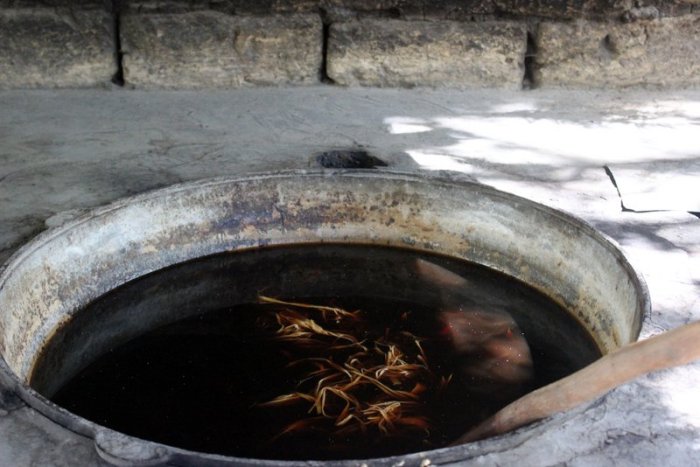
The boiled pulp is then mashed into a fine paste in a wooden pestle and mortar, which is powered by a traditional water wheel. Click here to see how the water wheel works.
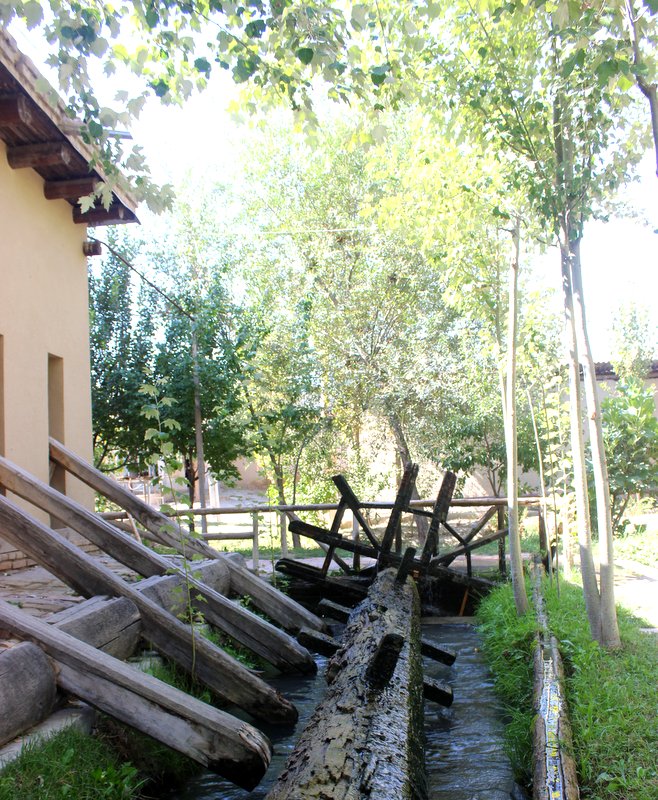
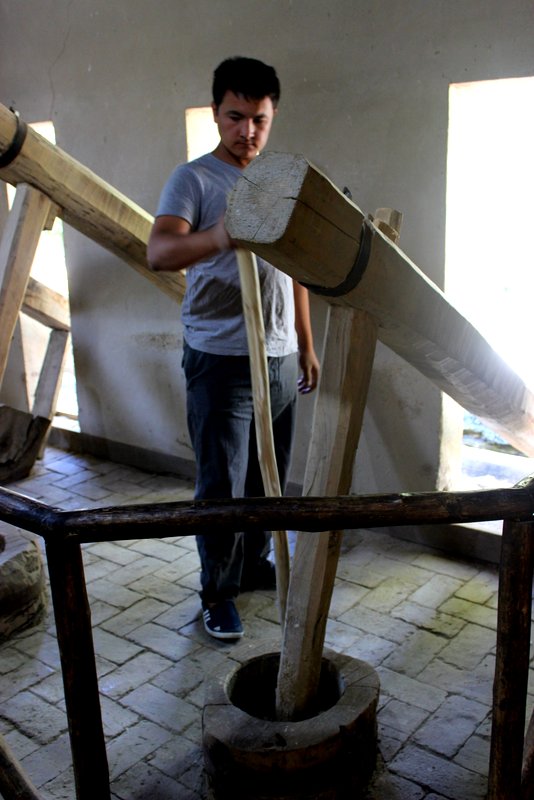
The pulp is then mixed with a binding solution and allowed to settle. And then it is a process of stir, dip the screen in the solution, remove it, let the water drain, place it between sheets of paper, cover with a slatted wooden board, place a stone weight on the paper pile, and then put it on a wall board to dry ! Click on the slide show below to see the full process !
Now comes the part of polishing the dried and rough silk paper. There are three stages of polishing with a shell, a piece of agate and finally onyx.
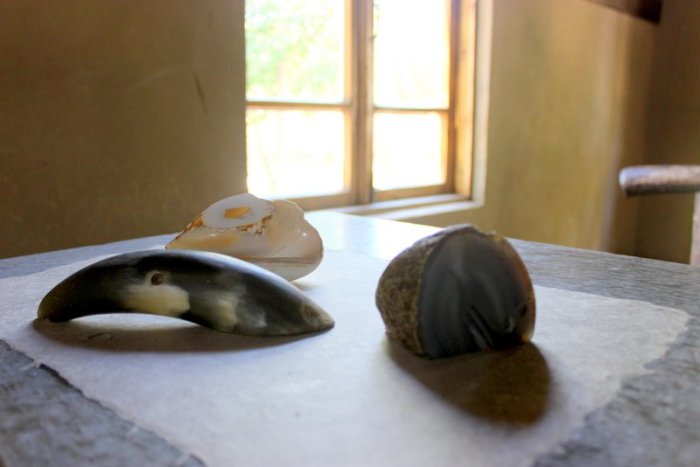
It is the polishing, which is done by hand, that determines the quality of the silk paper. The finer and shinier the silk paper, the more expensive it is. The best of the silk paper is exported or is purchased by museums and galleries for restoration work of old manuscripts. What is sold in souvenir shops, though very good, is not the best. The shop at Meros had stationery items as well as cute paper dolls, masks, bookmarks, etc. and I went a little berserk and bought quite a bit as gifts for friends and family. 🙂
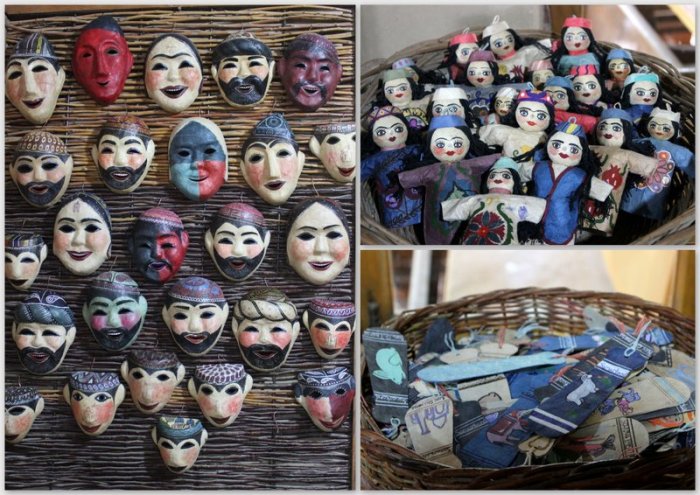
When I was relating to a friend about the trip to the Meros Silk Paper Factory, he remarked rather condescendingly that it sounded very touristy. I replied that perhaps it was, and would have been even more so, if it had been a working day with tourists crawling all over the place. But there are two things to be considered here.
One, I was a tourist there (yeah sure, I can call myself a traveller, but for the locals I would remain a tourist) and therefore it was perfectly normal for me to do touristy things. 😛
Two, and more importantly, this was my small way of supporting an ancient craft and the local economy as well. For me, no trip is complete without bringing back something that has been sourced and made locally. It is my way of saying thank you to a place for hosting me and for sharing their local culture with me.
Thank you, Meros for enlightening me with all things silk paper and for sharing a piece of your history with me. 🙂
My Dream Trip Uzbekistan Series:
Dear Uzbekistan | A city called Nukus | Art in the Desert: The Savitsky Collection at Nukus | Mizdahkan: A city for the dead | 3 forts & a dakhma | Itchan Kala of Khiva | There’s something about Bukhara! | Monumental Bukhara | The Jewish Heritage of Bukhara | Shakhrisabz: The home town of Amir Timur | The Registan Square of Samarqand | The blue city of Samarqand | The silk paper factory at Konigil | The surprise & delight that was Tashkent | Uzbekistan: The food & markets special | The Uzbekistan trip planner |
Join me on Twitter, Facebook and Instagram as I share all “My Favourite Things” with you.

How awesome Sudha! I loved this. Never thought such special kinds of paper existed. I had heard of the term ‘silk paper’ but I wasn’t aware that they were made so intricately and are treated so highly! By the way, after the pulp is stirred and boiled, the screen is inserted in the solution. So what is the screen? It picks up the liquid solution? Is it like a mould that holds the mixture in place until it takes the shape of paper? And then later after draining it is placed between sheets of paper. So these papers are just used as part of the process? They aren’t the skeleton on which the final product – the silk paper sits right?
LikeLiked by 1 person
How nice to see you here on the blog, Omkar. 🙂
The screen is like a very fine mesh and the water drains away leaving behind the pulp. Once the water drains away completely and the wet ‘paper’ can be lifted off it is placed between sheets of what look and feel like blotting paper to remove the moisture completely. A weight (in this case a stone) is placed on that pile and removed after some time. the final drying takes place on a board. Once fully dry, the paper is polished.
Hope this explains the process more clearly. 🙂
LikeLike
Those faces are beautiful. Its always the best thing to support local crafts.
LikeLike
I prefer to pick up locally made things as souvenirs and gifts rather than chocolates or the usual cheap magnets and key chains. I picked up paper from Konigil and embroidered cushion covers from Khiva and Bukhara. 🙂
LikeLiked by 1 person
That’s so interesting, I saw the Instagram video you posted and was quite curious about the process !!
LikeLike
Silk paper in itself is interesting. I didn’t get to see the real high quality stuff that is used for printing the Qur’an, but even the stuff that was there was pretty good !
LikeLike
What and intricate and beautiful process. Unlike most of the paper factories in our country, the family owned factory is well kept and clean. Loved the cheerful dolls and masks. The Black River is actually quite beautiful!
LikeLike
Neena, Uzbekistan is clean. Period. At least the parts that I visited were. One explanation is that the places that are frequented by the tourists are well maintained. But I don’t think so for I did drive through villages and walked in non-touristy portions as well – they were all clean.
Siab river is black due to high clay content. I think it looks rather deep and mysterious and secretive, don’t you?
LikeLike
I would have gone berserk too buying many gifts from the factory 🙂 No, I don’t think it’s touristy. As long as we are supporting their work through proper means and channels, I don’t see the harm in visiting these factories and giving their arts & crafts some exposure.
LikeLiked by 2 people
Kat, thank you so much for your comment. I strongly believe in supporting the local economy and glad you think so too.
Pssst: I went beserk at the factory. 😛
LikeLiked by 1 person
This is such a wonderful place and such pleasant craft. So fascinating to read about silk paper. Hopefully, I’ll get to visit someday and if not anything else, pick up a few bookmarks. 🙂
LikeLiked by 1 person
Its a wonderful place, Shekhar. And to see the paper form and dry and get polished is really something. I would think that the same procedure would be followed for handmade paper anywhere else in the world, with local variations. But since I was seeing the process for the first time, I was really fascinated. Not to mention the name “Silk Paper”. 🙂
LikeLiked by 1 person
🙂
LikeLike
So now I have also visited this place and the whole process of silk paper is indeed very fascinating. It may seem touristy but given the beautiful setting of this place, especially the water mill, it’s worth a visit.
LikeLike
Glad you liked the silk paper factory too, Sushmita. It may be touristy but that doesn’t make it less interesting. I found the place informative and I wouldn’t have known about silk paper if I hadn’t visited the factory. 🙂
LikeLike